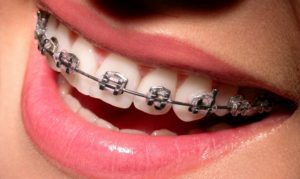 Modern medicine has made significant progress in the correction of malocclusion. Significant and not very defects in teeth can be corrected at almost any age.
Modern medicine has made significant progress in the correction of malocclusion. Significant and not very defects in teeth can be corrected at almost any age.
In addition, the patient is given a wide choice of bracket systems, differing in color and material, and in the price category.
Contents
- What is the bracket system
- Materials from which the brackets are made
- Variety of solutions
- Price
- How much does it cost to put the lingual braces?
- Installation of sapphire system
- Cost of other solutions
What is the bracket system
The bracket system is a non-removable design. It consists of small locks( brackets) connected together by means of a springing arc - a metal wire. It passes through each bracket, holding them and integrating into one system.
The orthodontic arch passing through separate braces acts as a tool for the movement of teeth in the desired direction. The effect is achieved due to the fact that under any conditions it necessarily assumes the original state.
In addition to the basic elements of the system( bracket-lock and arc), the system also contains auxiliary:
- brush locks;
- rubber bands;
- springs;
- rings.
The classic version involves connecting the arc and locks with metal or elastic ligatures. In more modern models, these fastening elements are provided in the structure and do not require additional fastening.
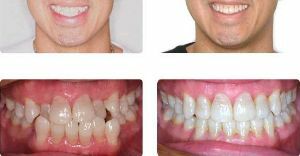 The advantage of braces before other adjusting devices is their ability to simulate the dentition simultaneously in three planes. And if necessary, with their help, an orthodontist can change the shape of the jawbone so that all the teeth can fit on it.
The advantage of braces before other adjusting devices is their ability to simulate the dentition simultaneously in three planes. And if necessary, with their help, an orthodontist can change the shape of the jawbone so that all the teeth can fit on it.
The time period that is necessary to correct the bite anomaly is strictly individual. It depends on the level of complexity of each case and the design chosen for installation.
Materials from which the braces
are made Depending on the material used for manufacturing, there are several basic types of ortho devices:
-
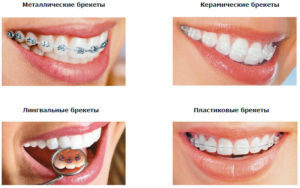 from medical steel;
from medical steel; - plastic;
- ceramic;
- of gold;
- sapphire.
Features of each of the bracket systems:
- Braces from medical stainless steel are the most widespread. Among their advantages can be identified the fastest achievement of the desired effect, high structural strength and low price. In addition, they are fairly simple to install and use. But this version of the orthodontic device most often causes allergic reactions and has an unsightly appearance.
- Systems made of polymer materials , are used in practice by far from every dental clinic. This is due to their low strength and short life. But they are in demand among patients, because they can be selected in a tone to the teeth and be unobtrusive during wearing.
- Ceramic braces , as well as plastic, are popular due to their imperceptibility on their teeth. The color of the braces can be precisely matched to the color of the tooth enamel. But unlike plastic, ceramics have considerable strength and elasticity. This material is hypoallergenic, does not cause injuries to the oral mucosa, does not change the color from the coloring products. The cost of ceramic systems relative to others has an average value.
- Gold systems appeared at the disposal of orthodontists relatively recently. To be more precise, the system is not completely made of precious metal. Locks of the structure are made of medical steel, but on top they are covered with a significant layer of gold. By their qualities, these braces are very similar to metal braces and are highly resistant. Because of the gold layer, they practically do not cause allergic reactions, but they have a very high price, so not every
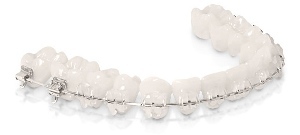 patient is available.
patient is available. - The most expensive of all possible are braces made by from sapphire ( single-crystal material).Very attractive in appearance: they are completely transparent and at a short distance it seems that they are really made of precious stones. Practically imperceptible on the teeth, they can be considered only at a sufficiently close distance. They do not cause an allergic reaction, but are fragile enough and are difficult to maintain.
Variety of solutions
In addition to the material used in the manufacture, the brackets also differ in their arrangement. They can be attached to the outer side of the teeth( vestibular) or to the inner( lingual).
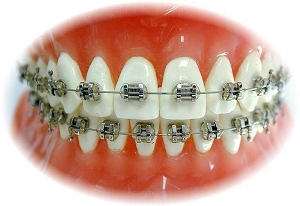 Both systems have their own advantages and disadvantages. Most often, patients choose their vestibular variant. They are attached to the front of the dentition. For their manufacture are used as very visible and inexpensive materials( medical steel), and almost invisible, characterized by a high price( ceramics, sapphire).
Both systems have their own advantages and disadvantages. Most often, patients choose their vestibular variant. They are attached to the front of the dentition. For their manufacture are used as very visible and inexpensive materials( medical steel), and almost invisible, characterized by a high price( ceramics, sapphire).
Vestibular systems with relatively low cost are easy to care for, they are strong, but they are very unsightly. Their more expensive counterparts have a more aesthetic appearance, but not everyone can afford it. External structures are easier to install, clean and maintain than internal ones.
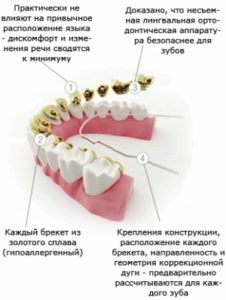 Lingual braces are used to correct bite much less often than vestibular ones. This is due to their high cost and complexity of installation. But still they managed to gain considerable popularity. This is due to their invisibility to prying eyes, since the corrective structure is attached to the inner( lingual) side of the dentition.
Lingual braces are used to correct bite much less often than vestibular ones. This is due to their high cost and complexity of installation. But still they managed to gain considerable popularity. This is due to their invisibility to prying eyes, since the corrective structure is attached to the inner( lingual) side of the dentition.
Regarding orthodontic qualities, invisible braces are good at correcting the most complex tooth anomalies. Lingual braces are made individually for each patient, and this fact undoubtedly influences their effectiveness.
From the minuses of the internal braces, it is possible to name:
- a violation of diction in the patient at the initial stage after installation( up to several days);
- is a more complex and lengthy installation process;
- need for the most thorough care and long cleaning;
- is very high cost.
Overview of the various bracket systems from an orthodontist:
Price of the question
From all of the above it becomes clear that the price of the bracket system depends on two factors:
- material from which it is made;
- location relative to the dentition: internal or external.
How much does it cost to put lingual braces?
So, the installation of invisible lingual brackets will cost the patient no more than 150 000 rubles. This amount will have to be given not once, because the procedure is carried out in several stages:
- Everything starts, usually with , the advice of the orthodontist .The primary reception specialist in the capital's clinics costs an average of 2500 rubles to 5000 rubles.
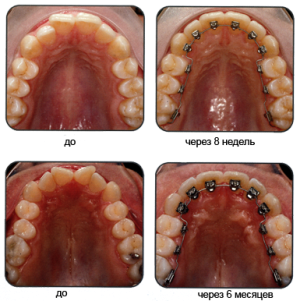
- Next stage - development of a detailed treatment plan for : a panoramic image of the jaw line, making casts, necessary analyzes and examinations, selection of the corrective system. For this it is necessary to give from 3500 rubles to 6500 rubles.
- Manufacture of internal braces system on the patient's jaws. Its cost starts from 80000-100000 rubles for one jaw. In most clinics this amount includes installation of the structure.
- After fixing the system throughout the correction period, it will take several times to visit the orthodontist to perform the correction of the braces .Each procedure is paid separately, with respect to lingual constructions it costs from 2500 rubles each. The correction is carried out on average once every two months.
- The last thing to be paid for is the removal of the corrective system and the installation of non-removable storage units. There is a procedure from 20,000 rubles.
The average cost of a full course of correction of an upper and lower jaw bite using invisible braces is about 250,000 rubles.
Installation of the sapphire system
Sapphire brackets are slightly cheaper than lingual systems, but the prices for them are also quite high.
- specialist consultation 2500-5000 rubles;
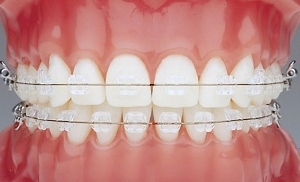
- development of the medical strategy 3500-5000 rubles;
- cost of a sapphire brace system, including installation on one jaw - 65000 rubles;
- one procedure for correction of braces from sapphire - from 1800-2000 rubles;
- removal of the system( including a retainer) - from 18,000 rubles.
The average cost of sapphire structures on both jaws is in the range of 120000-200000 rubles.
Cost of other solutions
Price of the other systems:
- Ceramic correction constructions are on average price equivalent. The full course of treatment with their use will cost about 80000-130000 rubles. The cost of related services is equivalent to what is needed when installing the
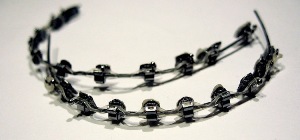 sapphire analog. But the price of the system for a single dentition - the upper jaw, is about 50 thousand rubles.
sapphire analog. But the price of the system for a single dentition - the upper jaw, is about 50 thousand rubles. - Plastic braces due to some features are not used by all dental clinics. By aesthetic properties they are close to ceramic, but the price for them and the quality of construction are lower. The cost of the system for the lower jaw is about 20,000-40000 rubles and the same for the upper one. The full correction is in the range of 40000-100000 rubles.
- Metal bracket systems are the cheapest and will cost the patient 30,000-90000 rubles for the correction of the teeth of the lower and upper jaw.
These are the average prices of dental clinics in Moscow, with an increase in the prestige of the institution, the cost of services is growing proportionally.
To reduce the total cost of specialists resort to installing different designs on the lower and upper jaw. So, on the upper dentition are attached invisible ceramic or sapphire structures, and for the lower row are limited to the metallic version.
